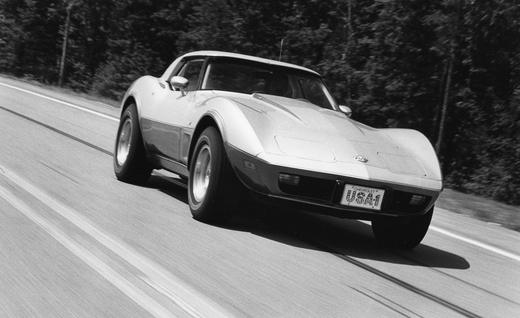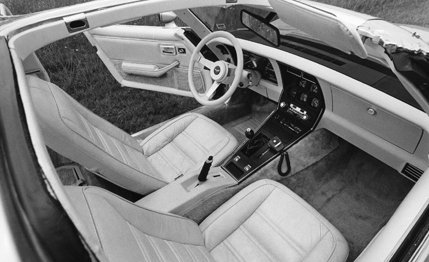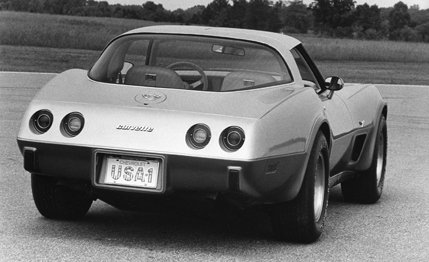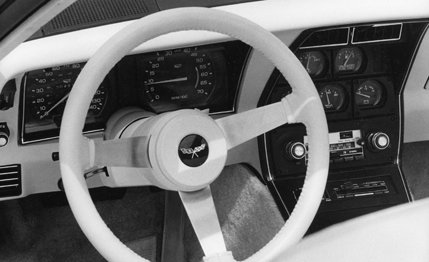1978 Chevrolet Corvette
Even after 25 years, the name is still magic.

Herewith we again present the Corvette, which might be described as the Jackie Onassis of automobiles. Like the former first-lady-heiress-Jet-Set-Juliet, America’s fiberglass sweetheart remains a subject of perpetual intrigue and fascination for the vox populi regardless of its age or impact on the larger scheme of things.
Moreover, Jackie O. and the Corvette have a larger-than-life quality about them, and regardless of their publicly demonstrated capabilities, we the people have invested them with a panache that defies empirical evidence. They are growing old together, these two media-ripened cult objects, but they persist in their ability to attract attention. Although in her forties and far beyond the gossamer glories of Camelot, Jackie is still newsstand dynamite in the movie mags and the gossip rags. The Corvette, as you may have noticed, is 25 this year, but its name and its radically planed shape retain unparalleled sales magic in the automotive press. The presentation of a Corvette on the cover of a magazine like this — especially if it is accompanied by a headline trumpeting “Exclusive! The Secret New 1984 Corvette!” produces irresistible Pavlovian responses among even slightly automotive readers, much as their counterpart, who read Modern Screen, react to nuggets like “Jackie O.’s Secret Affair!” (This of course leads one to speculate that perhaps the single, super-boffo cover blurb of all time might be “Exclusive! Jackie O.’s Secret New Corvette!” But that is a subject for another time.)
For the past few seasons, we of the automotive press have been faced with an unpleasant contradiction. It was this: Our beloved Corvette was getting old, fat and slow, and while the charisma persisted, the harsh truth was that as with Jackie, the best days were trailing off into dim memory. We pressed on, however, groping for superlatives as the old brawler’s weight bulged perilously near two tons and its emissions-constricted horsepower sagged toward numbers once reserved for Japanese four-door sedans.
Thankfully, that all seems to have passed. New illuminations of knowledge have descended upon Detroit’s engineering laboratories, permitting fresh lodes of horsepower to be extracted from clean-burning, no-lead-fueled engines, which means that the new 1978 Corvette comes to the showrooms with as much as 220 hp available from the optional L-82 350-cubic inch powerplant. (A respectable 185-hp — up five hp from 1977 — is packed into the base L-48 engine.)
In fact, after a number of recent Corvette editions that prompted us to mourn the steady decline of both performance and quality in this once-proud marque, we can happy report the twenty-fifth example of the Corvette is much improved across the board. Not only will it run faster now — the L-82 version with four-speed is certainly the fastest American production car, while the base L-48 automatic (0-60: 7.8 seconds, top speed: 123 mph) is no slouch — but general driveability and road manners are of a high order as well. The performance increase comes from two basic sources: a new, “dual-snorkel” air intake-air cleaner that supplies increased volumes of cool air to the engine and is worth about eight hp, and an improved, low-restriction dual exhaust system (with single catalytic muffler) that adds about five hp. An aluminum intake manifold also has been added, which produces some benefits in weight reduction but not in outright horsepower.
Some alterations in the transmission line-up have also been made to increase performance. The Muncie four-speed will be offered in conjunction with the base L-48 engine, replacing the 1977 Borg-Warner unit. The Muncie box uses a new 2.85-to-one first-gear ratio for better low-speed acceleration. In addition, the optional L-82 powerplant will have a lighter weight, CBC-type Turbo Hydra-matic automatic transmission with a low-inertia, high-stall-speed (2400 rpm) torque converter. Again, this will improve acceleration and should permit L-82 automatics to operate in the mid-fifteen-second quarter-mile range.
Good news also comes in suspensions, which have become increasingly soft over the past few generations. Now L-48 Corvettes with four-speed transmissions and all L-82 versions will carry a far more sinuous suspension package, which includes higher rate springs and larger diameter shock absorbers. This stiffer suspension, operating in company with the optional P255/60R-15 Goodyear GT Radial tires produces Corvette handling that is certainly superior to any in recent memory.
Regardless of all the good stuff that’s been added underneath, the big news from Corvette will center on its new rear roofline. (“Secret New Corvette Fastback!”) The conventional Corvette roofline, which has been around since the car’s last major body change in 1968, is gone now, replaced by a neat fastback version that will be the only model of the Corvette to be sold in 1978. This new rear-end treatment for the Corvette has to be described as a smashing success in terms of styling, but critics are already muttering that if Chevrolet went to the trouble of adding a fastback, why didn’t it go the full mile and make a hatchback?
The entire fastback project opened Pandora’s box for Corvette chief engineer Dave McClellan and his small staff. Obviously they were aware of the benefits of a full hatchback version, but given the restrictions of the aged Corvette rear-suspension layout — the same hulking, rather undistinguished, leaf-spring independent unit introduced in 1963 — and its attendant high frame-rail kickup, their options were severely limited. The space consumption of the suspension, plus the fuel tank, spare tire and dual mufflers, all of which are sardined into the Corvette’s stern, made the addition of a hatchback nearly impossible — or more correctly, the addition of a useful hatchback nearly impossible. Money was not available for a complete redesign of the car aft of the seats (which everyone privately agrees is desirable), so McClellan and his men set out to accomplish the following with the fastback: 1/increase usable space directly behind the seats, and 2/add to the Corvette’s traditionally modest fuel capacity.
They have reached both these objectives. A large, more useful storage cavity (8.4 cubic feet vs. 7.8 in ’77) has replaced the old, hard-to-use space. Not only is it bigger, but it provides an excellent environment for an optional four-speaker stereo system, a very important component in the post-berserker Corvette inventory. Valuables can be concealed by an ingenious vinyl curtain that can be drawn across the entire area. The Corvette’s credentials as a true GT car have always been blighted by its tiny 16.5-gallon fuel tank, which cuts the range for fast drivers to less than 200 miles. Now the tankage has been increased to 24 gallons in a redesigned fuel cell with a molded plastic inner liner. In order to accomplish this, the rear frame rails and suspension were slightly modified with a different spring assembly, smaller mufflers were installed and a narrow, special-tread P195/80D-15 bias-ply spare on a 15×5 steel wheel was utilized to extract the necessary extra space for the larger tank. It is easy enough to second-guess the manufacturers of automobiles, but when the limitations of space that exist in the back of the Corvette are understood, the reasons for not employing a hatchback layout become obvious.
There have also been some improvements within the interior of the twenty-fifth anniversary Corvette (that, incidentally, will carry special front and rear medallions commemorating the quarter-century mark in addition to an optional special sliver-paint package.) A neat, clean instrument panel featuring a large speedometer and tachometer behind non-reflecting glass is the most visible improvement, although old Corvette hands may cheer most loudly at the addition of a large, lockable glove box and the prospect of a new generation of high-support, Recaro/Scheel-type seats that will become available in March 1978. Also in the works (February 1978) are special, laminated see-through roof panels that will be strong, easy to install and not light (ballpark guess: 25 pounds each).
But enough of this technicalia. The question remains — has all this made any difference in the way the Corvette behaves? (“Exclusive: We Shake Out the Secret New Corvette!”) In a word, yes. An emphatic yes. It is obviously a taut, tough automobile that steers straighter, stops stronger and accelerates with more passion than any Corvette since the explosive days of the L-88, ZL-1 and LT-1. To be sure, this latest Corvette, even in the 220 hp L-82 form, isn’t going to rupture anybody’s spleen through the quarter-mile, but it presents a balance of overall performance that has been lacking in Corvettes for some time. Riding on the Goodyear GT radials, and utilizing the nicely articulated Muncie four-speed gearbox, the driver can run quickly in a Corvette under almost any conditions. Of course the old weaknesses persist; the rather high prow, which, in combination with the somewhat submerged seating position, tends to restrict close-up forward visibility, and the rear suspension, which still produces the distinct impression during quick directional changes that the back wheels have no interest whatsoever of coordinating their movements with the front pair. Nevertheless, the Corvette is a genuine pleasure to drive again.
Any story on any Corvette is not complete until speculation has been made about the “new” Corvette that has been implied since the early Seventies. (“Scoop: The Secret Mid-Engine Corvette!”) As many stories concerning this imaginary vehicle have been produced as those about Jackie O.’s Greek romances, and so far none have borne fruit. Chevrolet’s revelation of two Wankel-powered, mid-engine Corvette engineering prototypes several years ago generated a landslide of “new” Corvette stories that continue unabated to this day, and have caused otherwise rational men to insist that the next-generation Corvette will be a mid-engine vehicle. Right now all talk of a “new” Corvette involves only the wildest guesswork. The dozen engineers directly involved with the Corvette at this time compose only a small “maintenance” staff adequate to make running, evolutionary improvements on the existing model. If anything resembling an all-new model were to be created, staff size would have to be increased radically, and there is no indication that such an expansion is intended.
Little doubt remains that the new fastback model will be around at least through the 1980 model year. Changes of such magnitude are seldom marketed for less than two-year cycles, which implies that any new car is out of the question until 1981 at the earliest. Until that time McClellan and his group are going to attack the Corvette’s weight, with an eye to extracting at least 200 pounds from its bulk by 1980. McClellan will also aim at upgrading quality control — which, in terms of paint and body fit, has sagged badly during the past few years — and reliability in the areas of improved air conditioning and alternator belts (which tend to wobble off at high revs), windshield-wiper operation and window sealing. These may seem like fairly modest goals in contrast to lurid visions of mid-engine, turbocharged Countach knockoffs, but there is plenty of life left in the old model, and General Motors has never been known to kill an existing best seller in the whimsical urge to create an original model.
Because it would be impractical for GM to build a new facility to manufacture the uniquely fabricated Corvette, there is no question that customers will far exceed automobiles for the foreseeable future. Therefore, for better or worse, the headlines for the next few years should read: “Secret New Corvette? Forget It!”



